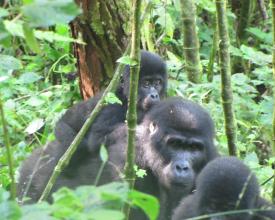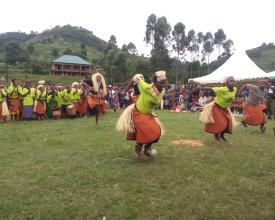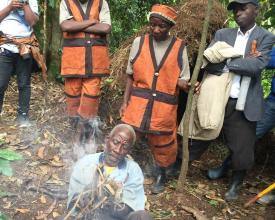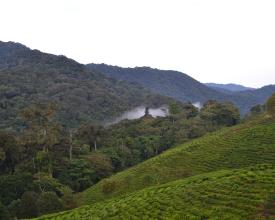
Intégration des valeurs culturelles des Batwa pour sauver les gorilles de montagne à Bwindi grâce au GAPA
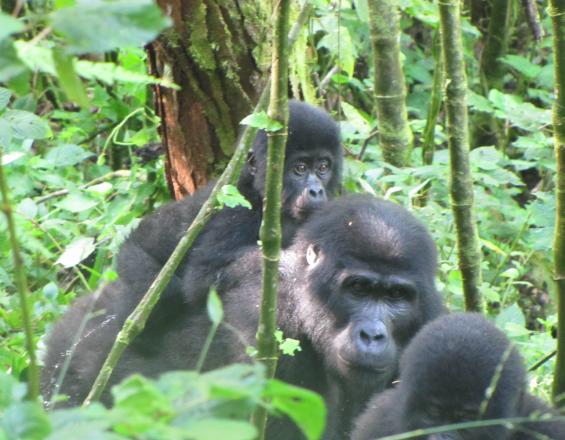
Les gorilles de montagne du monde sont menacés en raison des sources de subsistance et commerciales de la communauté. Avant le classement de Bwindi en 1991, les Batwa dépendaient des ressources de Bwindi comme de leur maison, ce qu'ils ont perdu après le classement. Par conséquent, ils représentent une menace pour les ressources les plus recherchées - les plantes médicinales et la viande de brousse. Grâce à une évaluation systématique de la gouvernance et à l'identification des actions prioritaires, les gestionnaires des zones protégées ont reconnu les complexités sous-jacentes de la gouvernance et ont identifié une approche fondée sur les valeurs culturelles pour assurer des moyens de subsistance durables à la communauté Batwa et la conservation de Bwindi. Grâce à cette évaluation, nous avons organisé la plantation par les Batwa d'arbres indigènes dans la communauté, sur la base de leurs valeurs traditionnelles et de leurs connaissances indigènes, afin de répondre à leurs besoins de subsistance et de générer des revenus par le biais de l'écotourisme et de la recherche. Nous espérons ainsi créer une barrière sociale contre le braconnage et réduire la pression sur les ressources protégées de Bwindi.
Contexte
Défis à relever
Défis environnementaux
Les gestionnaires des zones protégées n'ont pas compris les complexités de la gouvernance dans la zone de conservation de Bwindi Mgahinga (BMCA), qui ont conduit à des incidents de braconnage entraînant une perte de biodiversité. L'une des principales difficultés a été de ne pas reconnaître les valeurs culturelles des Batwa comme un moyen de promouvoir des moyens de subsistance durables et la conservation.
Défis sociaux et économiques
La participation des Batwa et des communautés locales aux réunions et aux activités du parc a été limitée. Ceci est dû au ressentiment des communautés locales causé par les pertes de récoltes et de bétail causées par les animaux sauvages. En outre, le peuple indigène Batwa a des options limitées en matière de sources de revenus en raison de sa position défavorisée dans la société et des préjugés des autres communautés non-Batwa. Cette discrimination limite la priorité accordée aux moyens de subsistance liés à la forêt.
Emplacement
Traiter
Résumé du processus
L'exercice d'évaluation de la gouvernance (bloc 1) a servi de base à la planification de l'action intégrée (bloc 2). L'évaluation de la gouvernance s'est appuyée sur un processus d'engagement multipartite, de la phase de préparation à la phase de planification de l'action/prise d'action. La sélection des acteurs s'est faite à dessein, en fonction de l'identification préalable lors de la planification et de la préparation de l'évaluation. Le plan d'action était de nature participative et les différentes parties prenantes ont identifié des domaines d'action prioritaires et ont assumé leurs responsabilités en termes de mise en œuvre des domaines d'action. Le plan d'action intégré a impliqué le regroupement d'actions locales et d'actions liées à la politique. Il est évident que les résultats de l'évaluation de la gouvernance ont créé une base pour les actions prioritaires. Si les domaines d'action sont mis en œuvre, la situation de la gouvernance de la zone de conservation de Bwindi Mgahinga s'améliorera et l'évaluation de la gouvernance aura donc un sens.
Blocs de construction
Évaluation de la gouvernance de la zone protégée
Avant l'évaluation de la gouvernance, nous avons entrepris un exercice de cadrage impliquant toutes les parties prenantes concernées. L'évaluation s'est appuyée sur un processus d'engagement multipartite et en plusieurs étapes pour l'exercice de cadrage, la collecte d'informations et la validation des résultats. L'atelier de cadrage a permis d'identifier les aspects clés de la gouvernance qui ont permis de sélectionner les principes de gouvernance essentiels à évaluer. Diverses questions de gouvernance ont été identifiées et la manière dont elles sont liées à la conservation de Bwindi. Les parties prenantes ont pu identifier les meilleures actions prioritaires alternatives et leur fonctionnement. Les parties prenantes ont pu identifier l'intégration des valeurs culturelles des Batwa comme une solution clé réalisable qui peut relier les populations indigènes à la conservation et à leurs moyens de subsistance. Diverses parties prenantes sont impliquées dans la mise en œuvre de l'approche fondée sur les valeurs culturelles afin d'en mesurer l'efficacité.
Facteurs favorables
-
Le soutien et la volonté de l'Uganda Wildlife Authority en tant qu'organisme de gestion des zones protégées ont été déterminants pour faciliter cette solution.
-
La reconnaissance de la complexité de la gouvernance comme un défi majeur pour la conservation par tous les acteurs tels que l'Uganda Wildlife Authority, le gouvernement local de Kisoro, Rubanda et Kanungu, les communautés locales (y compris les indigènes Batwa) et d'autres organisations de conservation.
-
Le financement du BIOPAMA a démontré qu'en utilisant efficacement de petites ressources, il est possible d'obtenir de meilleurs résultats.
Leçon apprise
-
L'identification et la résolution des problèmes de gouvernance ont été appréciées par les parties prenantes, qui y voient une voie vers la conservation durable et les moyens de subsistance.
-
L'implication de toutes les parties prenantes concernées est essentielle pour obtenir des résultats tangibles en matière de conservation et de moyens de subsistance. Elle nécessite un micro-engagement des acteurs et la manière dont ils acceptent de travailler ensemble.
-
Les politiques actuelles de gestion des zones protégées sont rigides et doivent être modifiées pour permettre l'intégration des aspects de gouvernance.
Plan d'action intégré par les parties prenantes
Avant l'évaluation, les parties prenantes planifiaient séparément au sein de leurs organisations respectives. L'évaluation a rassemblé l'Uganda Wildlife Authority, le Centre for Research Uptake in Africa, les gouvernements locaux de Kanungu, Rubanda et Kisoro et d'autres organisations de conservation clés telles que Bwindi Mgahinga Conservation Trust, International Gorilla Conservation Programme, United Batwa Organisation Development in Uganda, Bwindi Batwa Community Development Association et Uplift the Rural Poor pour qu'ils élaborent collectivement un plan d'action intégré et assument la responsabilité de leurs actions et de leurs inactions. Cela n'avait pas eu lieu depuis longtemps. Après le plan d'action intégré, chaque acteur a pu prendre sa part d'actions.
Facteurs favorables
-
Le désir de résoudre les conflits entre la zone protégée et les communautés locales
-
La reconnaissance des responsabilités et des rôles de chaque partie prenante en matière de conservation durable et de moyens de subsistance.
-
L'engagement des acteurs à résoudre le problème de la duplication des services dans l'aire de conservation de Bwindi Mgahinga.
Leçon apprise
-
La planification intégrée par les différents acteurs conduit à des interventions ciblées et à des résultats plus larges en matière de conservation et de moyens de subsistance.
-
Les acteurs souhaitent travailler ensemble, mais ils manquent de collaboration, de coordination et de ressources.
-
La planification intégrée à l'aide de la GAPA est un aspect clé de la responsabilité et garantit des actions rapides pour relever les défis sous-jacents en matière de gouvernance.
Impacts
Les parties prenantes ont beaucoup apprécié le lien entre la culture, la nature et les moyens de subsistance. L'évaluation a mis en lumière les complexités de la gouvernance, ce qui a permis de responsabiliser toutes les parties prenantes. Un nouveau projet axé sur la plantation d'arbres indigènes a été élaboré et financé par la Fondation internationale de l'arbre, ce qui a permis de créer une forêt de poche communautaire à Bwindi. Le fait de lier la culture des Batwa à la conservation de la nature et aux moyens de subsistance les reconnecte à la nature et ravive leurs valeurs de conservation. On espère que les Batwa deviendront des éclaireurs anti-braconnage en fournissant une barrière sociale aux incidents de braconnage, ce qui réduit la pression sur les ressources de Bwindi. Le braconnage est passé de 60 % à 30 % et aucun Mutwa n'a été trouvé en train de braconner au cours des 12 derniers mois. Les Batwa ont commencé à gagner de l'argent en guidant les touristes et les chercheurs dans l'identification des arbres indigènes, en particulier les plantes médicinales.
Bénéficiaires
Les populations indigènes Batwa - Elles sont traditionnellement connues comme des populations forestières qui vivaient dans les forêts tropicales.
Populations locales non batwa - Elles comprennent les communautés Bakiga et Bafumbira.
La direction et le personnel de l'Uganda Wildlife Authority
Objectifs de développement durable
Histoire
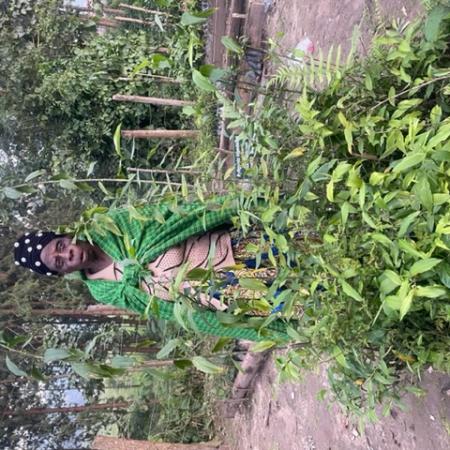
Je m'appelle Jovanisi Nyiragasigwa, une aînée mutwa. Je suis la présidente du comité de plantation d'arbres et de ressources. Je suis à la tête de 12 autres Batwa qui ont constamment collecté des animaux sauvages dans le parc et planté des arbres sur les terres de la communauté. En tant que Batwa, nous étions négligés, mais grâce au Dr Medard Twinamatsiko, qui a mené une évaluation de la gouvernance, les valeurs culturelles et les connaissances indigènes des Batwa, qui vivaient autrefois dans la forêt, ont été reconnues. Medard est devenu comme notre père. L'évaluation a permis de réunir les principales parties prenantes, en particulier celles que nous craignions auparavant d'impliquer en tant que Batwa. Les réunions d'évaluation et les ateliers auxquels j'ai participé m'ont permis d'acquérir de nouvelles façons de penser et de travailler ensemble, ainsi que d'autres compétences interpersonnelles. Après la reconnaissance de nos valeurs culturelles, l'Uganda Wildlife Authority nous a autorisés à collecter des plantes sauvages et des semis dans la zone protégée pour les planter sur les terres de la communauté. Chaque fois que je vais à Bwindi, je me reconnecte avec la nature et j'apprécie la valeur de la conservation. Je me sens toujours en contact avec mes ancêtres et nos aînés traditionnels. Cela m'aide à me reconnecter avec mon monde naturel. Je passe par nos sites culturels tels que les lieux de culte, les grands arbres et les grottes lorsque je recueille des animaux sauvages. Cela me donne envie d'aimer davantage la conservation et de soutenir l'UWA pour préserver Bwindi. Je crois que lorsque nos arbres pousseront, nous obtiendrons des médicaments et des aliments sauvages qui seront bons pour notre santé. Tout cela n'aurait pas été possible sans l'exercice d'évaluation de la gouvernance auquel nous avons participé.
